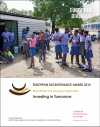Author: Michael O'Connor-Joana Afonso of Portsmouth Business School
Portsmouth Business School was delighted to host the recent 5th European Research Conference on Microfinance from 12th to 14th June in England. Thankfully the weather gods obliged with over 130 delegates attending the event over each of the three days. A mix of established researchers with a number of leading practitioners infused the financial inclusion debate with insights and thought-provoking panel presentations. Topical themes across gender, Islamic microfinance, Fintech, research and the future of microfinance were probed in wide-ranging panel discussions. The event was opened by Andy Thorpe (Portsmouth Business School) and Christoph Pausch (e-MFP) and commenced by asking whether microfinance would live to the year 2030, a chilling prospect in itself. If so, under what guise would it do so – is there still the well-trodden ‘promise’ of microfinance? What are the challenges to its realisation? In the opening session chaired by Dirk Zetzsche (University of Luxembourg) perspectives were shared by Marek Hudon (Université Libre de Bruxelles and CERMi), Annette Krauss (University of Zurich), Sam Mendelson (Financial Inclusion Forum UK and Arc Finance) and Kimanthi Mutua (Sidian Bank Kenya). The panellists set the tone for the ensuing debate across increasing risks and regulation in the sector, the likelihood or not of possible downscaling by commercial banks and upscaling by microfinance institutions and the growing need for institutions to have appropriate strategies to survive. The panel arrived at a broad consensus as to the requirement to adjust to increasingly emerging technology-driven solutions in the context of growing levels of private capital and related product solutions offered by new market participants.










0